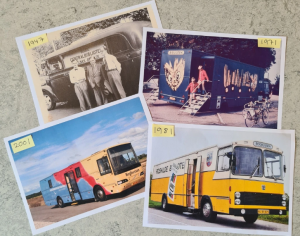I have been drawn to the issue of accessibility – not just making services accessible on site and online, but also accessible to remote patrons. Bookmobiles are one example of reaching the communities who are too far from and/or are unable to transport themselves to the nearest library. Without solutions like this, remote communities easily become non-users of the library, and then the question arises: are their needs being met?
Libraries strive to support and engage their communities to create a strong and open society. Programs and services are designed to meet specific needs identified in these communities and statistics focus on the number of circulations or program attendance. Unfortunately, community-centered services can leave out remote patrons. This exclusion of part of the population can be extremely detrimental. As Lauersen (2018) noted, “inclusion makes you thrive mentally and physically, gives us the opportunity to learn from others and to help others and it can help us feel that we belong.”
In my own location, 47.6% of the population live in the largest cities, leaving most of the population spread out in rural, and often remote, areas (HCOE, n.d.). The bookmobile that serves some of those remote communities offers books and other library materials that can be browsed or requested ahead of time, prizes for kids, participation in the Summer Reading Program, and a knowledgeable librarian to answer questions and help connect people with resources (Humboldt County Library, n.d.).
Rural areas are less likely to have consistent internet access, making online services difficult or impossible to use (Swan et al., 2013). Mobile solutions, like bookmobiles, are a great strategy for bridging the gap. Resources and opportunities delivered to remote patrons allow them to connect with needed information and remain an inclusive part of the community. From finding details on housing and job opportunities to engaging the imagination with mobile storytimes, on-the-go library services can make a huge difference in the lives of people who could otherwise struggle without this kind of support. Traditional services as well as technological services delivered to remote areas can build stronger communities outward.
Examples of services for remote patrons
-

Lauersen, 2025.
Lauersen (2025) reported on a Danish bookmobile that brought together people of small village communities. He noted that this service not only engaged the community with library resources, but also served to combat isolation and improve societal welfare. Investing in library services that can make strong connections such as this is necessary through collaboration between information organizations and the people they serve.
- A community-funded bookmobile for Quincy Public Library in Illinois supports their remote patrons, from kids to seniors (Muddy River News, 2025). They offer access to traditional books, audiobooks, movies, wireless internet, printing and copying, and a knowledgeable librarian. Budgetary issues removed the mobile library for some time, but the community saw the importance of the library experience for those who cannot physically get to the public library (Quincy Public Library, n.d.).
-

FELA, 2014.
In Northern Colombia, a “Biblioburros” – a mobile library carried on the backs of two donkeys – visits remote farming communities (Rocketboom, 2009). The schoolteacher who runs the program from his home is committed to providing books and personal connection for children. This service supports literacy, lifelong learning, and empowerment for those who would otherwise be without.
References
Federation of European Literacy Associations. (2014, May, 14). [Photograph of the Biblioburro in Colombia].
Humboldt County Library. (n.d.). Bookmobile. Humboldt County.
Humboldt County Library – Eureka Main Branch. (2025, May 10). [Photograph of a bookmobile parked on the side of a remote, rainy road]. Facebook.
Humboldt County Office of Education. (n.d.). Fast facts.
Lauersen, C. (2018, June 7). Do you want to dance? Inclusion and belonging in libraries and beyond. The Library Lab.
Lauersen, C. (2025, February 5). The necessary nearness – an ode to bookmobiles. The Library Lab.
Muddy River News. (2025, April 25). Book nook: To the bookmobile! [Video]. YouTube.
Quincy Public Library. (n.d.). Mobile library.
Rocketboom. (2009, September 30). Library on a donkey [Video]. YouTube.
Swan, D. W., Grimes, J., & Owens, T. (2013, September). The state of small and rural libraries in the United States. Institute of Museum and Library Services.
Hi Jenna,
I always love when Biblioburros comes up. It always warms my heart! I think that bookmobiles are such an amazing way to reach out to communities that are unable to make it to the library – for whatever reason. A public library near me goes to a senior center weekly in their book mobile to still have a way to engage that part of the community that cannot always make it into the library.
Great post!
Hello Jenna! Rural internet access is definitely a big issue. At my library system in Jackson County, Southern Oregon (nearby and somewhat similar to yours in Humboldt) we have been offering Wi-Fi hotspots as a temporary solution since 2018, but they unfortunately are retiring the service next month due to issues with excessive costs due to loss and damage as well as the cost of the service itself. In that time, many patrons have come to depend on us for their internet access. They also offer a van that brings laptops and Wi-Fi to rural patrons, but I’m worried about their ability to keep up with demand given that our hold list for the hotspots numbered in the hundreds. Love the style of your blog BTW!
@jlindberg thanks for sharing these strong examples for remote services and bookmobiles. This is an important aspect of our services and I’m wondering what more is possible within the realm of mobile libraries. Your last paragraph resonates with me as a call action.
@iant I am sorry to read about the hotspot, circulation sun setting. I hope there is something that can replace that that might be more reasonably cost-effective.